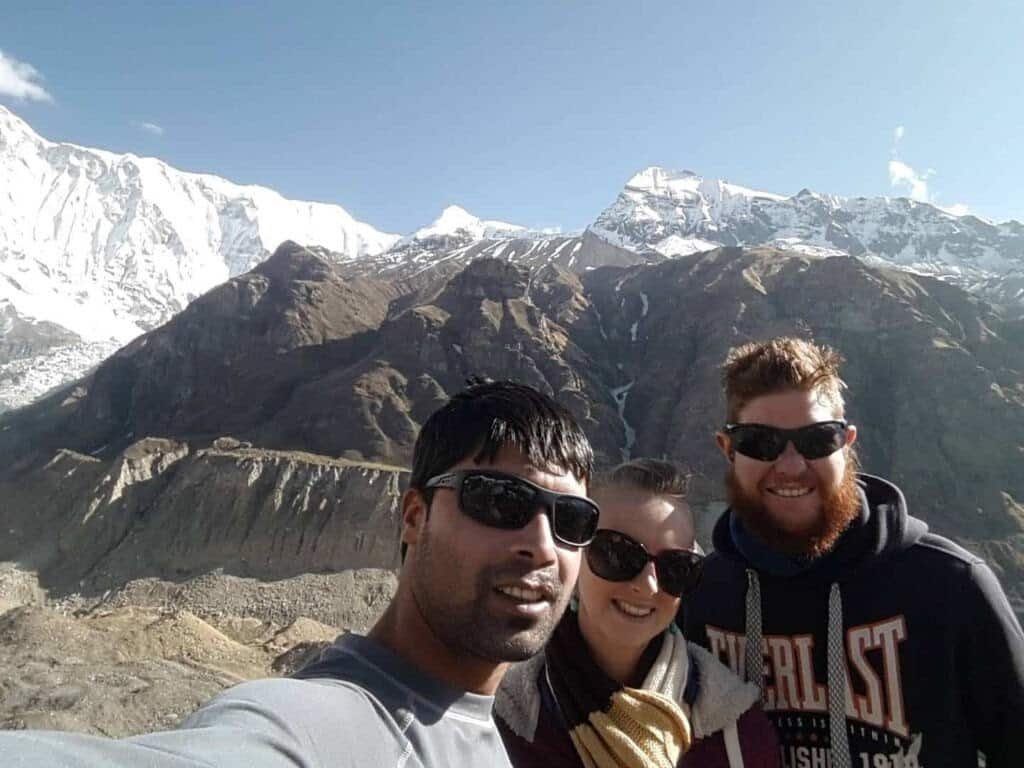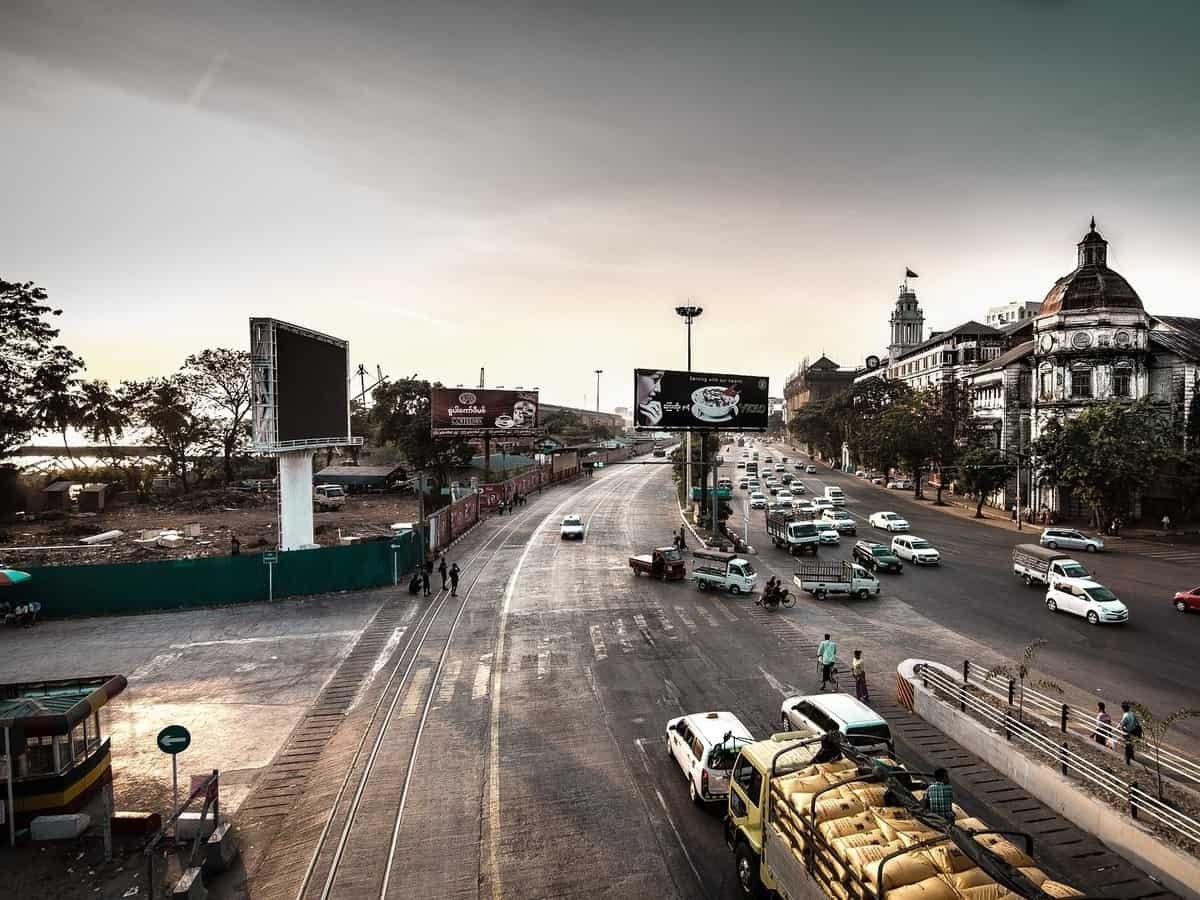Your guide to independent trekking in Nepal, Himalaya tour packages, a packing guide, and preparation tips, so you can get the most out of your Himalaya trip!
This guide was written by Ollie & Lynette On The World
Contents
Where Are The Himalayas
The Himalayan Mountains are one of the most diverse regions in the world and are home to many of the world’s highest peaks, including the highest, Mount Everest.
The Himalayas include over fifty mountains exceeding 7,200m in elevation, including ten of the fourteen 8,000-metre peaks.
The Himalayan mountain range runs west-northwest to east-southeast in an arc 2,400 km long. It is home to 52.7 million people spreading across five countries: Nepal, India, Bhutan, China, and Pakistan.

Hiking options in this vast area are in abundance, ranging from half-day to 45-day treks! We have explored a lot of this area and done many hikes and treks.
Options, prices, and scenery differ between countries, depending on where you decide to trek from. We have done most of our trekking from Nepal, which is the most popular place for trekking.
Here are our top tips for trekking independently.
Trekking in Nepal – Types of Treks
In Nepal, there are two types of treks you can do.
A homestay/teahouse trek is where you’ll stay in simple homestays or teahouses with a room, toilet, and meals.
The other option is camping treks, which will be much more off the beaten track, requiring a guide, tent, cooking equipment, food, and other supplies, carried by horses or mules.
Camping treks will often require more expensive permits but offer a much more authentic and less touristic trekking experience.
Well-known Treks in Nepal:
- Poon Hill – 5 days
- Annapurna Base Camp trek – 7-10 days, and
- The Everest Base Camp trek – 14 days, if you fly into and out of Lukla.
All of them can be done with or without a guide, given the fact that the trails are easy to find/follow, and they are well-known by locals.
There are also lesser-known treks in Nepal and the Indian states of Uttarakhand, Himachal Pradesh, Sikkim, and Jammu and Kashmir.
A fellow traveler said that in Uttarakhand alone, there are over 400 possible treks and that only 200 or so of them are known of!
Guided Trek Options
It is possible to trek without a guide; however, a guide offers information on local customs, stories, regional songs, and general information that you wouldn’t get otherwise.
If it’s your first trekking experience and you’d simply feel better off having one, options and companies are plentiful!
Whether you research on the internet or look around when you get to your destination, do your research. Look at their websites, Trip Advisor reviews, and even ask around if people have used them before.
We’ve researched a few Himalaya tour options for you.

Nepal Trekking Packages
Everest Base Camp Trekking Tour Options
Annapurna Trekking Options
Poon Hill Hiking Trips
For us, the guide makes or breaks a Himalaya trekking experience. If they are friendly and personable, then you’re likely to have a good experience.
Typically, you’re looking at paying up to US$20-25 per day for a guide, not including food and accommodation, but this can vary.

Independent Trekking
Trekking in Nepal independently is becoming a more popular option for many as it is much cheaper and offers you the freedom to go at your own pace, stop when you like, and not have to keep up with a large group.
As long as you have the right kit and a bit of know-how, trekking independently can be an empowering and fulfilling achievement!
What to Pack
So, what to pack?! Keeping your backpack light is essential as you’ll be carrying it for most of the day if you are trekking independently, or if you are going on a guided tour, a donkey will most likely carry your heavy backpack, and you need to think about a day pack.
Here are some things you should take:
- First aid kit
- Phone/camera
- Hat, Scarf, gloves, sunglasses
- Raincoat/poncho
- Backpack rain cover
- Water bottle (and water purification tablets as buying water in the mountains is expensive!)
- Snacks: trail mix, nuts, biscuits, chocolate (always handy to give you instant energy!)
- 2-4 sets of clothing, including a clean/dry set to wear once you reach your overnight stop.
- A good, comfortable pair of shoes/boots that are worn in before you go. There’s nothing worse than having sore, blistered feet because of your footwear!
Tips To Be Prepared For Your Trek
So that you can feel fully prepared and ready, here are our top tips for a successful and enjoyable trek:
Be Physically Ready
If you’ve never trekked before, make sure you take some time to prepare yourself by walking or increasing your general fitness before leaving home.
Consider going on some shorter treks before attempting anything more significant.
Allow Time For Acclimatization
This is important to avoid AMS – Acute Mountain Sickness. Don’t increase your sleeping altitude by more than 500m per day and, at higher elevations, allow for acclimatization days for your body to get used to the reduced oxygen.
If you are flying into a high altitude destination, such as Leh in India, don’t start trekking immediately.
Rest for a couple of days while your body adjusts.
Eat and Drink
Consume lots of water (around 2 liters a day depending on altitude) and more food than usual, mainly carbohydrates. Increased carbohydrates are essential for your body because of the extra calories you’ll burn both when trekking and at altitude.
Ensure That Your Paperwork is in Order
Make sure that you have your trekking permits paid for and with you. It’s a good idea to have your passport and copies of other documents, such as insurance, with you as well just in case.
Insurance
Accidents do happen, and if you need assistance getting off the mountains, in some cases, you won’t be taken by a rescue team unless you can prove valid insurance to cover the costs.
Make sure you check out your insurance options. World Nomads covers trekking; you can check out the cost of insurance with this handy insurance tool.
Inform Others of Your Plans
Whether you’re going solo or guided, inform your hotel or friends and family where you are going, how long for and when you plan to return.
Phone signal/Wi-Fi isn’t always available in the mountains, and even though thousands of people trek safely every year, accidents can happen.
Money, Money, Money
Prices in the mountains are HIGH, and they get higher the further up you go.
Accommodation is cheap, but food and beverages are not because of transportation costs.
Ensure that you have plenty of cash in local currency and some US$ just in case.
Even if you pay for an all-inclusive package, note that not EVERYTHING is included (such as that extra tea or packet of biscuits that you had after lunch!)
Accommodation
Once you are on the trekking trail and making your way along the route, the only available accommodation is in simple tea houses.
There is no way to book these in advance. If you are trekking with a guide, they would typically call ahead to book for you, but if you are trekking independently, you have no choice but to arrange it on arrival.
If a place is full, you just have to find somewhere else. This can be beneficial as you can look at options before settling on one.
Ordinarily, you would eat at the place you stay in as the menus are preset and priced by the government, so it’s pretty much the same everywhere.
Accommodation is basic but cheap (200-600 Nepali rupees, 2-6US$). The beds and duvets have seen better and cleaner days in most cases, so arranging a sleeping bag or at least a sleeping bag liner is advisable.
The food portions are reasonable, given the price, and we would personally recommend eating dal bhat in Nepal (rice, lentils, veg, and pickles). It comes with free refills, making it good value for money.
It’s what all the guides and porters eat to keep their energy reserves up! Their saying of “Dal Bhat Power, 24 Hour!” is very apt!

You can find options for hotels in Kathmandu or Pokhara, for before or after your stay for a little R&R.
Hotels in Kathmandu
Check out the current prices for hotels in Kathmandu on TripAdvisor
Hotels in Pokhara
Find the best deal for hotels in Pokhara at TripAdvisor
We are sure that by following this advice, you will have an unforgettable time trekking in some of the most beautiful landscapes on Earth.
The views of the mountains are simply breathtaking with the flora and fauna and pine forests; moreover, watching the simplicity of the local way of life will, we think, make you fall in love with the mountains and their resilient people.
Have you done any hiking in the Himalayas? If you have any tips or information for our readers, leave a comment below!
Want to see more about trekking in Nepal?




